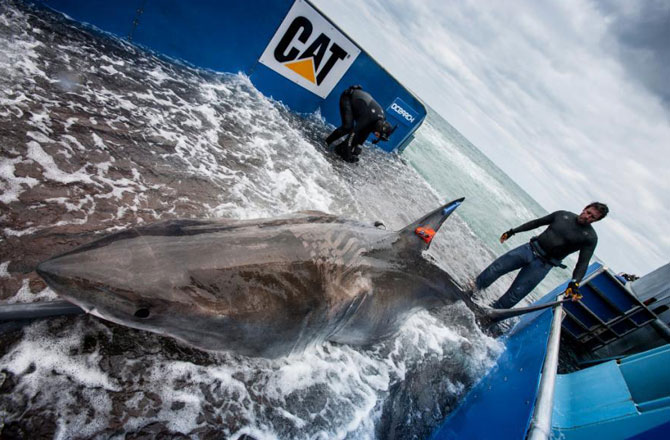Great White Shark On Historic Marathon Migration

A great white shark called Lydia is set to make history. First tagged a year ago off the Florida coast, she's on her way to becoming the first tracked white shark to cross the Atlantic.
Lydia is being monitored by the marine nonprofit Ocearch as part of its ongoing project to help researchers and scientists gather previously unattainable data on shark movement, biology and health. The 14-foot-6-inch great white has migrated more than 19,000 miles since being tagged, and is about to cross the mid-Atlantic ridge -- closer to Europe than the United States.
Top 10 Most Incredible Shark Journeys
Over time, Ocearch has collaborated with over 50 researchers from more than 20 institutions. The team that tagged Lydia included Massachusetts Division of Marine Fisheries senior scientist Greg Skomal. Tracking helps the scientists learn more about great white shark biology, he told me last summer. And that could mean providing beach managers with better information to keep both the sharks and the public safe.
The Ocearch team uses two different kinds of electronic tags, Skomal explained. One is a pop-up satellite tag that can archive data such as depth and light levels. The tag can be programmed to release from the shark and then float on the water surface to transmit data back to the scientists.
NEWS: Shark Scientists Pit Robot Against Human
Another is a real-time satellite tag, which connects to a satellite whenever the shark comes to the surface, providing data about the shark's movements so scientists -- and the public -- can follow a shark's migration patterns over a long time. This is what Lydia has.
Sign up for the Live Science daily newsletter now
Get the world’s most fascinating discoveries delivered straight to your inbox.
In order to tag a great white shark, the team first had to lure it to a smaller boat -- no easy task -- then catch the shark safely and transfer it to the main Ocearch vessel via hydraulic lift. The team only had 15 minutes to attach tracking tech, do scans, take a small sample and then release the shark. In August, they successfully tagged a 14-foot-2-inch great white named Katharine and followed her progress from Cape Cod to Daytona Beach, Florida.
In the future, an underwater robot could even track tagged great white sharks. Skomal, a Shark Week veteran (video), has been working on an autonomous underwater shark tracking robot that can compete with the robots that West Coast shark trackers Chris Lowe and Chris Clark are developing. "For science purposes it's great to know everything you possibly can about all the animals on Earth. White sharks are no exception," Skomal said.
This story was provided by Discovery News.









